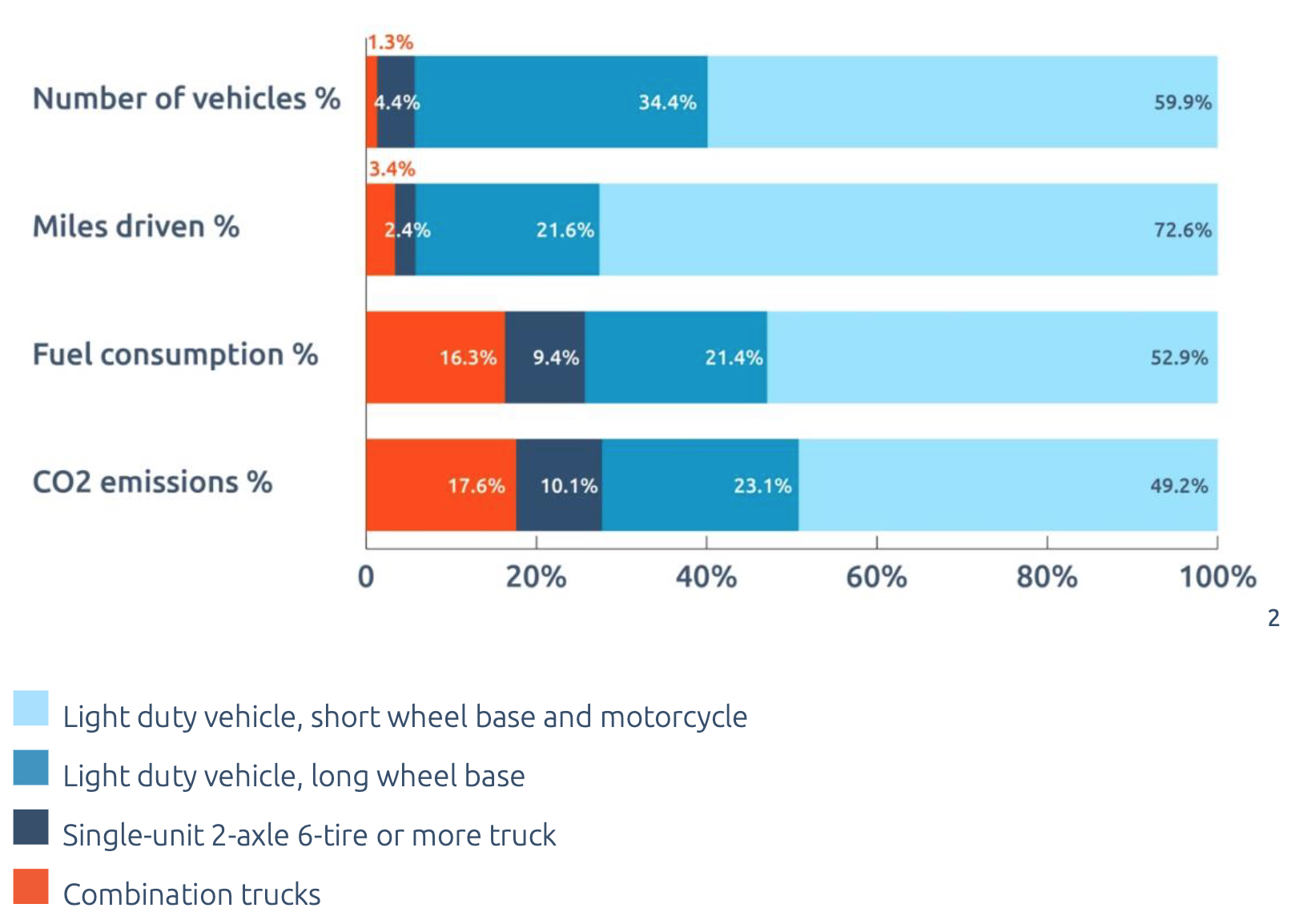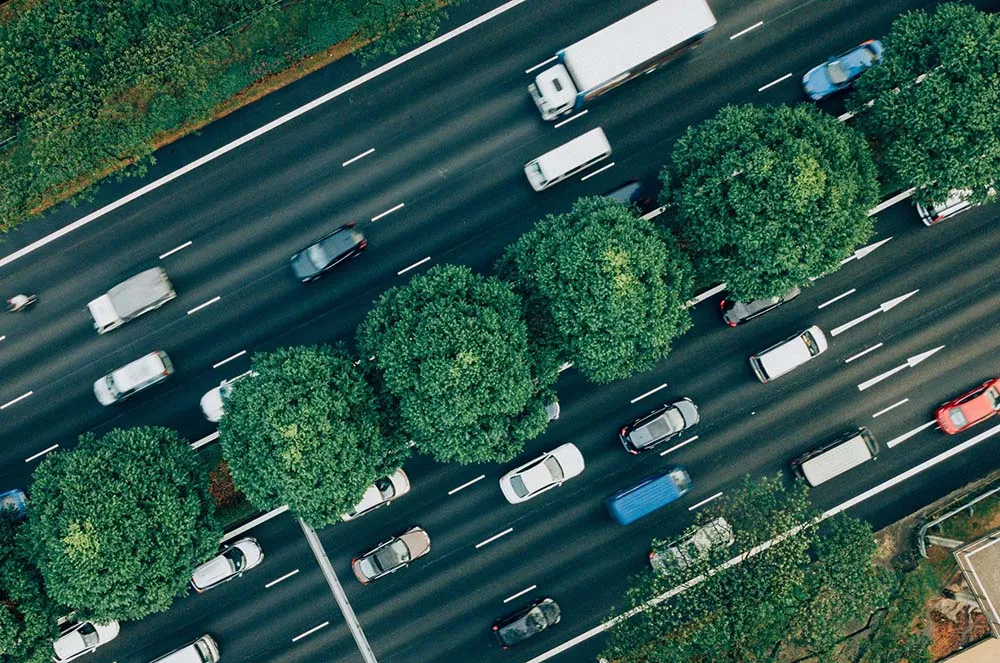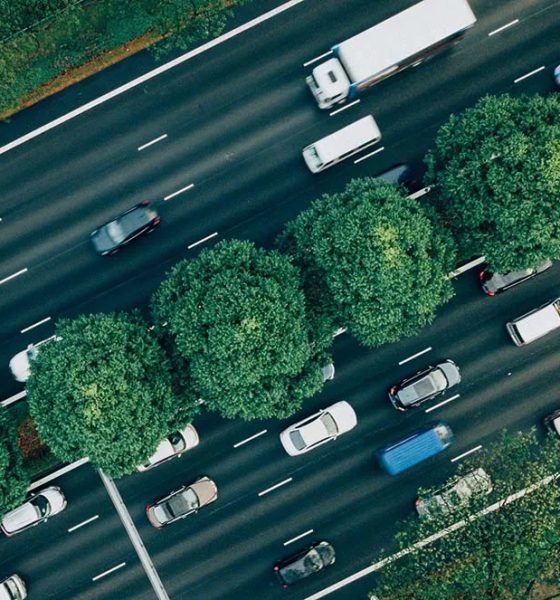A new report shows that commercial vehicles are much higher polluters than passenger vehicles despite making up a much smaller portion of cars on U.S. roads. For this reason, the study’s authors say the U.S. should prioritize electrifying the commercial vehicles sector rather than just focusing on passenger vehicles.
PepsiCo- and KPMG-backed software logistics company Adiona Tech shared the Connected Thinking report on Tuesday, which suggests that last-mile combination trucks be electrified as soon as possible to help fight CO2 emissions. The company says that all urban deliveries of groceries, parcels, furniture and other goods should be performed by electric vehicles (EVs) by 2025.
“Commercial vehicles are a much bigger polluter than passenger cars and they are in desperate need of modernization,” Adiona writes in the report. “Large combination trucks are just 1 percent of vehicles on the road, but they produce 18 percent of vehicle emissions.”
The study compared Bureau of Transportation Statistics figures from 2019 to those of 2020 and 2021, looking at vehicle miles driven by passenger cars and trucks, along with their associated emissions. What it found was that emissions decreased significantly in 2020 and 2021, while truck miles and their associated emissions increased above 18 percent of road traffic emissions.

Sources: Connected Fleet data; BTS, fuel consumption by mode, additional combination truck stats, additional car stats, additional single-axle truck stats. Credit: Adiona Tech
The report included several key findings, notably including that the average fuel consumption of combination trucks is roughly 20 times higher than that of a passenger vehicle. The report also says that switching just five of these combination trucks to green alternatives — such as hydrogen fuel cells or lithium batteries — would be comparable to the effects of buying EVs for 100 households.
While the average truck drives about 22,930 miles annually, the report notes that large combination trucks travel an average of 59,929 miles in the same period, and single-unit trucks only average 12,278 miles annually.
According to data sourced from the Bureau of Transportation, light-duty vehicles with a short wheelbase have an average fuel consumption of 481 gallons per year, compared to 640 gallons consumed on average by light-duty vehicles with long wheelbases, and 1,639 gallons on average by single-unit, two-axle trucks with six tires or more. However, the data also shows that combination trucks consume an average of 9,909 gallons annually.
In a press release, Adiona Tech CEO Richard Savoie highlights the need to prioritize larger freight in the fight against carbon emissions, beginning with those that travel the most.
“America needs to aggressively decarbonize the biggest emitters on the road, large freight and delivery vehicles,” Savoie said in the release. “The US automotive industry is at a crossroads, but it needs to act now to electrify every car on the road. Doing so requires connected thinking and collective action. We cannot transform the national fleet of nearly 300 million vehicles overnight, so we need to make decisions that make the biggest difference, for the lowest effort first.”
The passenger vehicle sector has adopted EVs much more quickly than others, as several automakers have now followed Tesla’s lead in building fully electric vehicles. While electrifying every car is still an important goal, Savoie explains, it shouldn’t be the only one.
“Frankly, the data shows that consumer adoption of EVs should not be America’s number one priority,” Savoie said. “Electrifying fleets is by far the most efficient way to reduce vehicle emissions. Every battery we put in a combination truck counts for 20 households buying an EV, and businesses often have fleets of hundreds of vehicles.”
“We must prioritize the electrification of these vehicles that are on the road most, travel the longest distances, and are the least fuel-efficient,” Savoie added.
Several companies have begun piloting or at least stated plans to purchase electric last-mile delivery vehicles, including FedEx, Amazon, Walmart and more.
Adiona Tech backer PepsiCo is one of the first companies to have begun electrifying its semi-truck fleet after purchasing an initial batch of Tesla Semis last year. A recent event showed some serious range results for the Semi, and PepsiCo detailed last month how the truck was helping it reach its own sustainability goals.
You can read the full report from Adiona Tech here.
What are your thoughts? Let me know at zach@teslarati.com, find me on X at @zacharyvisconti, or send your tips to us at tips@teslarati.com.

News
Tesla FSD fleet is nearing 7 billion total miles, including 2.5 billion city miles
As can be seen on Tesla’s official FSD webpage, vehicles equipped with the system have now navigated over 6.99 billion miles.

Tesla’s Full Self-Driving (Supervised) fleet is closing in on almost 7 billion total miles driven, as per data posted by the company on its official FSD webpage.
These figures hint at the massive scale of data fueling Tesla’s rapid FSD improvements, which have been quite notable as of late.
FSD mileage milestones
As can be seen on Tesla’s official FSD webpage, vehicles equipped with the system have now navigated over 6.99 billion miles. Tesla owner and avid FSD tester Whole Mars Catalog also shared a screenshot indicating that from the nearly 7 billion miles traveled by the FSD fleet, more than 2.5 billion miles were driven inside cities.
City miles are particularly valuable for complex urban scenarios like unprotected turns, pedestrian interactions, and traffic lights. This is also the difference-maker for FSD, as only complex solutions, such as Waymo’s self-driving taxis, operate similarly on inner-city streets. And even then, incidents such as the San Francisco blackouts have proven challenging for sensor-rich vehicles like Waymos.
Tesla’s data edge
Tesla has a number of advantages in the autonomous vehicle sector, one of which is the size of its fleet and the number of vehicles training FSD on real-world roads. Tesla’s nearly 7 billion FSD miles then allow the company to roll out updates that make its vehicles behave like they are being driven by experienced drivers, even if they are operating on their own.
So notable are Tesla’s improvements to FSD that NVIDIA Director of Robotics Jim Fan, after experiencing FSD v14, noted that the system is the first AI that passes what he described as a “Physical Turing Test.”
“Despite knowing exactly how robot learning works, I still find it magical watching the steering wheel turn by itself. First it feels surreal, next it becomes routine. Then, like the smartphone, taking it away actively hurts. This is how humanity gets rewired and glued to god-like technologies,” Fan wrote in a post on X.
News
Tesla starts showing how FSD will change lives in Europe
Local officials tested the system on narrow country roads and were impressed by FSD’s smooth, human-like driving, with some calling the service a game-changer for everyday life in areas that are far from urban centers.

Tesla has launched Europe’s first public shuttle service using Full Self-Driving (Supervised) in the rural Eifelkreis Bitburg-Prüm region of Germany, demonstrating how the technology can restore independence and mobility for people who struggle with limited transport options.
Local officials tested the system on narrow country roads and were impressed by FSD’s smooth, human-like driving, with some calling the service a game-changer for everyday life in areas that are far from urban centers.
Officials see real impact on rural residents
Arzfeld Mayor Johannes Kuhl and District Administrator Andreas Kruppert personally tested the Tesla shuttle service. This allowed them to see just how well FSD navigated winding lanes and rural roads confidently. Kruppert said, “Autonomous driving sounds like science fiction to many, but we simply see here that it works totally well in rural regions too.” Kuhl, for his part, also noted that FSD “feels like a very experienced driver.”
The pilot complements the area’s “Citizen Bus” program, which provides on-demand rides for elderly residents who can no longer drive themselves. Tesla Europe shared a video of a demonstration of the service, highlighting how FSD gives people their freedom back, even in places where public transport is not as prevalent.
What the Ministry for Economic Affairs and Transport says
Rhineland-Palatinate’s Minister Daniela Schmitt supported the project, praising the collaboration that made this “first of its kind in Europe” possible. As per the ministry, the rural rollout for the service shows FSD’s potential beyond major cities, and it delivers tangible benefits like grocery runs, doctor visits, and social connections for isolated residents.
“Reliable and flexible mobility is especially vital in rural areas. With the launch of a shuttle service using self-driving vehicles (FSD supervised) by Tesla in the Eifelkreis Bitburg-Prüm, an innovative pilot project is now getting underway that complements local community bus services. It is the first project of its kind in Europe.
“The result is a real gain for rural mobility: greater accessibility, more flexibility and tangible benefits for everyday life. A strong signal for innovation, cooperation and future-oriented mobility beyond urban centers,” the ministry wrote in a LinkedIn post.
News
Tesla China quietly posts Robotaxi-related job listing
Tesla China is currently seeking a Low Voltage Electrical Engineer to work on circuit board design for the company’s autonomous vehicles.

Tesla has posted a new job listing in Shanghai explicitly tied to its Robotaxi program, fueling speculation that the company is preparing to launch its dedicated autonomous ride-hailing service in China.
As noted in the listing, Tesla China is currently seeking a Low Voltage Electrical Engineer to work on circuit board design for the company’s autonomous vehicles.
Robotaxi-specific role
The listing, which was shared on social media platform X by industry watcher @tslaming, suggested that Tesla China is looking to fill the role urgently. The job listing itself specifically mentions that the person hired for the role will be working on the Low Voltage Hardware team, which would design the circuit boards that would serve as the nervous system of the Robotaxi.
Key tasks for the role, as indicated in the job listing, include collaboration with PCB layout, firmware, mechanical, program management, and validation teams, among other responsibilities. The role is based in Shanghai.
China Robotaxi launch
China represents a massive potential market for robotaxis, with its dense urban centers and supportive policies in select cities. Tesla has limited permission to roll out FSD in the country, though despite this, its vehicles have been hailed as among the best in the market when it comes to autonomous features. So far, at least, it appears that China supports Tesla’s FSD and Robotaxi rollout.
This was hinted at in November, when Tesla brought the Cybercab to the 8th China International Import Expo (CIIE) in Shanghai, marking the first time that the autonomous two-seater was brought to the Asia-Pacific region. The vehicle, despite not having a release date in China, received a significant amount of interest among the event’s attendees.










